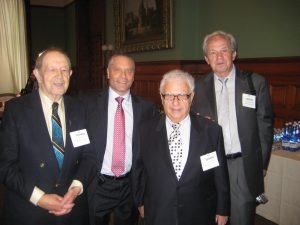In recent years, Holocaust-related art has pushed in extreme directions. This season’s provocative book is Affinity Konar’s Mischling, which chooses as its focus twin girls trapped in the pseudo-experiments overseen by Josef Mengele at Auschwitz.
Last year’s foreign film Oscar went to Son of Saul, which brings the viewer into intimate proximity with the workday of the camp’s Sonderkommando. And at this past summer’s Venice Biennale, among the most critically honoured art exhibits in Europe, historian Robert Jan van Pelt reproduced one of the chutes used to drop Zyklon B into the gas chamber at Auschwitz, painted, like everything else in his presentation, in sparkling white. Interviewed by the New York Times, he intoned that his exhibit consisted of “one of the most deadly things so far created.”
Harry Rajchgot’s new novel, Gravitational Fields, highlights aspects of the war and its aftermath that eschew these kinds of spectacular themes. The book attends instead to issues that have been neglected by creative artists. These include the early years of German occupation in Poland; the lives of partisans in Polish forests and rural byways; and the war’s immediate aftermath, as survivors returned to their home towns or found themselves stuck in the strange interregnum offered by displaced persons camps in Germany.
Though Rajchgot’s narrative includes its share of the sort of suspense and grisly violence associated with wartime narratives, its approach is, for the most part, intimate. We come to understand the novel’s view of history through its depiction of characters, their voices and outlooks, as well as through Rajchgot’s efforts to link the extremes of wartime with both prewar normality and survivors’ struggles to right their lives in postwar Montreal and Israel.
Gravitational Fields starts out in Montreal, tracing the movement of the Gryn family as they make the archetypal postwar move from downtown streets to the slightly more upscale but mundane neighbourhood of Notre Dame de Grace. The Old-World flavour of Esplanade is abandoned in favour of an NDG home with a “small garden in the back of the house, and a patch of grass and bushes in the front. There was even a garage in the back for the car…” Duvid Gryn, the newly Canadianized father, is Rajchgot’s avenue to the novel’s main story of Polish wartime events.
The reader senses great authorial effort – whether via research, interviews or travel – to inhabit his material as intimately as possible. The Polish countryside is evoked in impressive detail as Duvid’s wartime experiences unfold. As a hunted Jew in occupied Poland, Duvid’s attention to the landscape has a lifesaving quality: “He knew the barns where corn was stored for the cows… He remembered where the odd tree might have a few wrinkled apples left on its branches, or scattered about the ground.”
Rajchgot chooses particularity, of place, time and personal experience, over the extreme entry points used in some recent Holocaust art.
Duvid’s village north of Warsaw is sketched with care: “The young men’s house lay on the end of town, where the Jews lived, away from the main street. The landmarks of the area were the synagogue and its associated structures, the bath house, the cemetery, the rabbi’s house, the religious school and the kosher butcher shop. Close by was the Catholic church… The meal for the Sabbath day was started some hours before sundown in the slow-cooking chulent pot. Special clothes were donned, and the Sabbath evening meal of challah, gefilte fish, boiled chicken and noodle soup was served.”
The novel pushes, as well, in the direction of philosophical and religious inquiry with regard to the disastrous outcome of 20th-century events. In this, Rajchgot opens his neatly delineated narrative to some of the broader and familiar themes associated with wartime literature.
Gravitational Fields invites two different kinds of readers: those who yearn for a big canvas of ideas and intellectual questing regarding the war, as well as those who prefer to see events sketched more intimately, by way of a character’s actions and thoughts.






